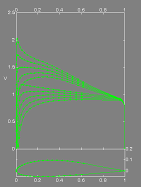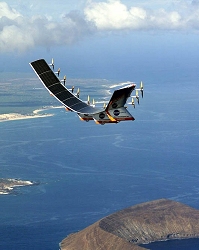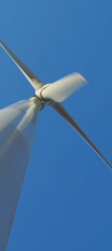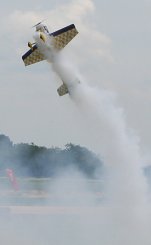Research Interests in Applied Aerodynamics
Applied aerodynamics is the art and science of taking what we understand about the fundamentals of fluid flow and applying that to make a better aerodynamic system. Sometimes the process begins by researching the basic underlying fluid dynamics of the flow around some object, e.g. airfoil stall or rotors in steep descent. Other times when the fluid dynamics are better understood, it focuses on using aerodynamics tools and "know-how" in the process of advancing and optimizing the design of a system, e.g. designing a new airfoil to optimize a system like a new airplane, UAV or wind turbine.
 Applied aerodynamics covers a broad range of topics involving generally any object that experiences aerodynamic forces in fluid
flow, e.g. aircraft, wind turbines, yachts, automobiles/race cars,
trains, sports balls, birds and insects to name a few. Currently,
most of our particular research interests tend to center around and
have impact on the following areas below.
Applied aerodynamics covers a broad range of topics involving generally any object that experiences aerodynamic forces in fluid
flow, e.g. aircraft, wind turbines, yachts, automobiles/race cars,
trains, sports balls, birds and insects to name a few. Currently,
most of our particular research interests tend to center around and
have impact on the following areas below.
Airfoil Design and Validation
Unique airfoil requirements and interests in improving aerodynamic
efficiency are drivers on our research into airfoil design and
validation. Methods at UIUC build off of an inverse design
approach whereby the desired aerodynamic characteristics are
specified from which the geometry is determined. At the heart of
the approach is the inverse design code
PROFOIL, which
has been used to design single-element airfoils, multi-element
airfoils, airfoils in  cascade and airfoil in distributions along wings, i.e. 3D methods. The suite of 2D and 3D flow codes developed and built
around the core PROFOIL engine have been applied in the design of
airfoils and wings that are in use worldwide for a range of
military and civilian applications. Some examples are airfoils for
model aircraft, UAVs, homebuilt aircraft, large and small wind
turbines as well as designs used in the America's Cup and Formula 1
racing series. New designs are validated using CFD methods and wind tunnel testing at UIUC. Some sponsors of our research have
included NASA, AeroVironment, Boeing, Naval Research Lab, GE, Siemens, Northern Power Systems, Ford Motorsports, NHR, Jaguar Racing
and Oracle-BMW Racing, Farr Yacht Design and many others.
cascade and airfoil in distributions along wings, i.e. 3D methods. The suite of 2D and 3D flow codes developed and built
around the core PROFOIL engine have been applied in the design of
airfoils and wings that are in use worldwide for a range of
military and civilian applications. Some examples are airfoils for
model aircraft, UAVs, homebuilt aircraft, large and small wind
turbines as well as designs used in the America's Cup and Formula 1
racing series. New designs are validated using CFD methods and wind tunnel testing at UIUC. Some sponsors of our research have
included NASA, AeroVironment, Boeing, Naval Research Lab, GE, Siemens, Northern Power Systems, Ford Motorsports, NHR, Jaguar Racing
and Oracle-BMW Racing, Farr Yacht Design and many others.
Low Reynolds Number Aerodynamics of Airfoils, Propellers and Vehicles
Model aircraft, MAVs/UAVs, cooling fans and many other systems
operating at small scale and low speeds can experience low Reynolds
number flow effects. Low Reynolds numbers are also experienced on
aircraft with low wing loadings flying at very high altitudes, such
as 40,000 ft and above.  If the aerodynamics are not managed well,
the performance of such systems can seriously degrade and become
economically and technically infeasible. For a conventionally
shaped airfoil, these problems can occur when the Reynolds number
falls below approximately 500,000. Low Reynolds number aerodynamics
has been one focal point of our research in the UIUC Applied
Aerodynamics Group. We have designed and tested new airfoils that
are used in aerospace, wind energy, motorsports and sailing. Some
examples include airfoil designs for the NASA/AeroVironment solar
powered aircraft (e.g. 247-ft span flying-wing Centurion and Helios),
AeroVironment Global Observer, UAVs, many model aircraft as well as
airfoils for the wing-keel bulbs in the America's Cup and
aerodynamic wings used in CART and Formula 1 designs. Research
into the aerodynamics of low Reynolds number propellers is also
ongoing. Over 100 propellers have been wind tunnel tested in
straight flight, yawed flow and in steep descent. Also,
full-vehicle low Reynolds number aerodynamics of UAVs is an area of
research in our group. For more see UIUC
LSATs.
If the aerodynamics are not managed well,
the performance of such systems can seriously degrade and become
economically and technically infeasible. For a conventionally
shaped airfoil, these problems can occur when the Reynolds number
falls below approximately 500,000. Low Reynolds number aerodynamics
has been one focal point of our research in the UIUC Applied
Aerodynamics Group. We have designed and tested new airfoils that
are used in aerospace, wind energy, motorsports and sailing. Some
examples include airfoil designs for the NASA/AeroVironment solar
powered aircraft (e.g. 247-ft span flying-wing Centurion and Helios),
AeroVironment Global Observer, UAVs, many model aircraft as well as
airfoils for the wing-keel bulbs in the America's Cup and
aerodynamic wings used in CART and Formula 1 designs. Research
into the aerodynamics of low Reynolds number propellers is also
ongoing. Over 100 propellers have been wind tunnel tested in
straight flight, yawed flow and in steep descent. Also,
full-vehicle low Reynolds number aerodynamics of UAVs is an area of
research in our group. For more see UIUC
LSATs.
Wind Turbine Blade Design and Wind Energy Research
Wind energy is growing at an unprecedented rate. Our research in
this area centers around airfoil designs for wind turbine blades as
well as the aerodynamic design of the entire rotor.
 We have used
PROFOIL for wind turbine airfoil design and PROPID for inverse
design of variable-speed and constant-speed rotor blades. One
variant, PROPGA, is a hybrid approach that combines the advantages
of an inverse design method with the optimization power of a
genetic algorithm. These methods include approaches to capture
high angle of attack post-stall aerodynamics. Areas of current
research range from blade design with very thick airfoils for
mega-watt scale large wind turbines to the airfoil and blade design
for low Reynolds number small rotor systems. Applications of these
methods include the large ~70-m dia 1.5-MW GE wind turbine (see
patents) as well as many medium- and small-size rotor systems for
companies and for government sponsored research. Research into 3D
stall delay continues to be a challenging and interesting area of
study. For more see the PROPID webpage.
We have used
PROFOIL for wind turbine airfoil design and PROPID for inverse
design of variable-speed and constant-speed rotor blades. One
variant, PROPGA, is a hybrid approach that combines the advantages
of an inverse design method with the optimization power of a
genetic algorithm. These methods include approaches to capture
high angle of attack post-stall aerodynamics. Areas of current
research range from blade design with very thick airfoils for
mega-watt scale large wind turbines to the airfoil and blade design
for low Reynolds number small rotor systems. Applications of these
methods include the large ~70-m dia 1.5-MW GE wind turbine (see
patents) as well as many medium- and small-size rotor systems for
companies and for government sponsored research. Research into 3D
stall delay continues to be a challenging and interesting area of
study. For more see the PROPID webpage.
Realtime Flight Simulation and Computational Flight Dynamics
Our research in realtime flight simulation of aircraft covers a
broad spectrum. Over 30 small-scale UAV-sized aircraft (RC
aircraft in fact) have been modeled in the flight simulation
software FS One, which is now being used on campus in our research.
Flight vehicles as small as 3 grams ("nano" MAVs) up to
full-scale size are modeled in realtime at 300 Hz using a 4th-order
Runge-Kutta integration  scheme. The aerodynamics methods embodied in the base-code
include a spectrum of nonlinear low Reynolds number effects and
high angle of attack post-stall aerodynamics which give rise to a
range of interesting topics for research such as the aerodynamics
of airplane hover, unsteady lift and drag modeling in dynamic
maneuvers, and incipient and fully-developed aircraft spin.
Research in flight simulation at UIUC has also included realtime
modeling of the early IAI Pioneer UAV, the NASA Twin Otter icing
research aircraft, and the University of Toronto full-scale
ornithopter to name a few. One of our current efforts in flight
simulation and modeling is aimed at aircraft dynamics and control
for energy extraction from wind shear and random gusts,
e.g. dynamic soaring. Our work in flight simulation and modeling
research has also been applied to aircraft accidents. Experience
has also been applied to better understand aircraft loss of control
in one of the worst aviation accidents in US history.
scheme. The aerodynamics methods embodied in the base-code
include a spectrum of nonlinear low Reynolds number effects and
high angle of attack post-stall aerodynamics which give rise to a
range of interesting topics for research such as the aerodynamics
of airplane hover, unsteady lift and drag modeling in dynamic
maneuvers, and incipient and fully-developed aircraft spin.
Research in flight simulation at UIUC has also included realtime
modeling of the early IAI Pioneer UAV, the NASA Twin Otter icing
research aircraft, and the University of Toronto full-scale
ornithopter to name a few. One of our current efforts in flight
simulation and modeling is aimed at aircraft dynamics and control
for energy extraction from wind shear and random gusts,
e.g. dynamic soaring. Our work in flight simulation and modeling
research has also been applied to aircraft accidents. Experience
has also been applied to better understand aircraft loss of control
in one of the worst aviation accidents in US history.



